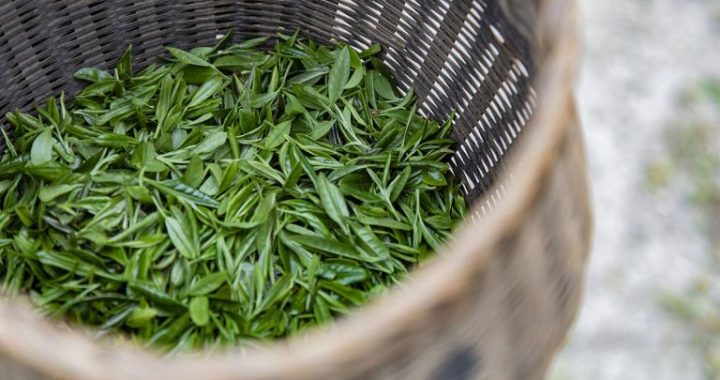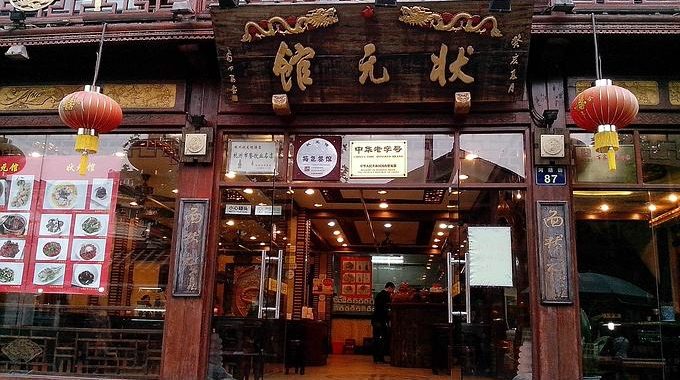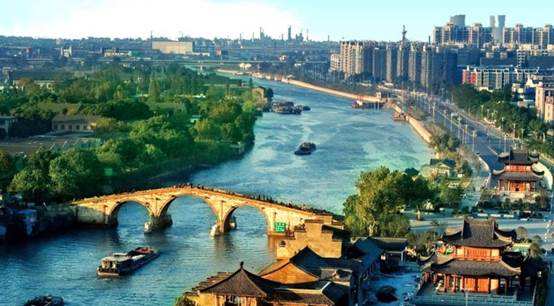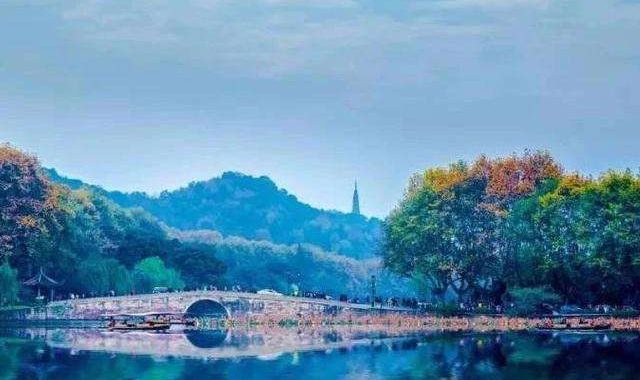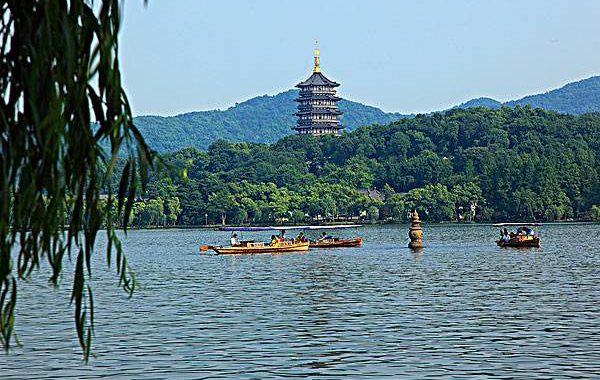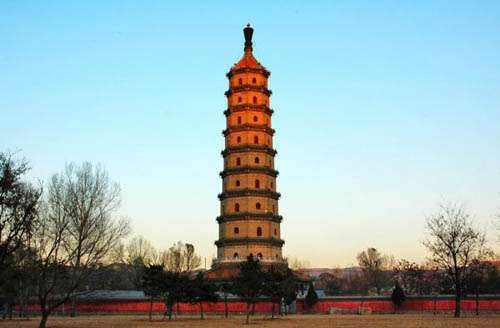Top 10 Scenes of West Lake
14 min readThis is where locals and visitors alike go to get away from it all:200,000 square meters of beauty and willows. In spring, the songs of the orioles ring through the willows, mixed with elderly Hangzhou residents crooning classical Chinese opera odes. The orioles in China aren’t just favored for their song; they’ re a symbol of vitality and the natural order. Ming Dynasty poet Wan Dafu wrote of this place,”The singing of the orioles never stops in the forest; also, somewhere on the pleasure boats over the lake comes more music.”
Autumn Moon over the Calm lake
When late autumn looms and the moon is full, the scenery here is renowned for its romance. Located at Bai Causeway’s western point on Gushan Hill, this spot is one of the best places for a panoramic view of the lake. Of course, you can also jump on a boat, cruising while appreciating the serenity of the moonlit lake like a real Song Dynasty connoisseur.Considering the great Emperor Kangxi of the Qing Dynasty enjoyed this particular spot,it’s guaranteed not to disappoint.With a garden,a stele pavilion,awinding bridge,and Gushan Hill behind you,there is plenty to see before nightfall.
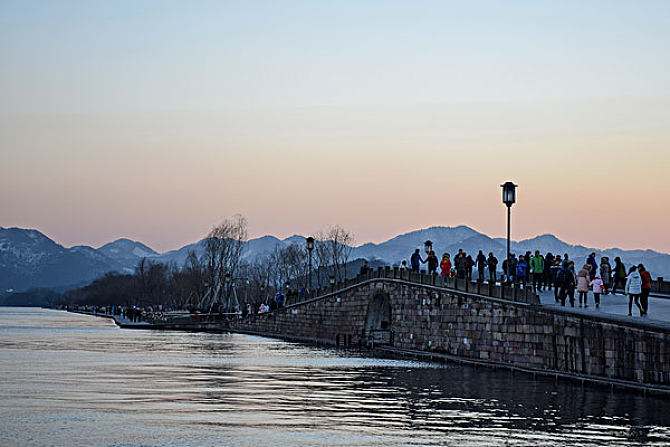
Twin Peaks Piercing the Clouds
Whether you’re in it for the exercise or just trying to get a little closer to the divine,the north and south peaks of the eastern stretch of the Tianmu Mountain range can’t be missed.The best viewing spot for the twin peaks is by the Hongchun Bridge in the northwest corner of West Lake.If you’re lucky enough to be visiting on a foggy day,you will see both peaks poking through the haze during a morning stroll.About five kilometers apart,the South Peak is over 256 meters tall,about 100 meters shorter than the Northern Peak.A hike to the North Peak will take you through the Lingyin Temple scenic area.
Lingering Snow on the Broken Bridge
When rare snow hits, this area is abuzz with visitors (particularly couples) looking for that perfect snapshot of the Broken Bridge. Located at the east end of the Bai Causeway in the north of the lake, the Broken Bridge, contrary to its name, is firm and intact. It onlyappears to be broken after a snowfall when the sunny side of the bridge melts the newly-fallen flakes. With its dark brown surface revealed, it creates an illusion that the bridge is broken from the Bai Causeway. But what really makes this site spectacular is its role in the famous folk tale”Legend of the White Snake”-as the spot where the couple in this romantic story first met-making it one of the most romantic spots in Hangzhou.
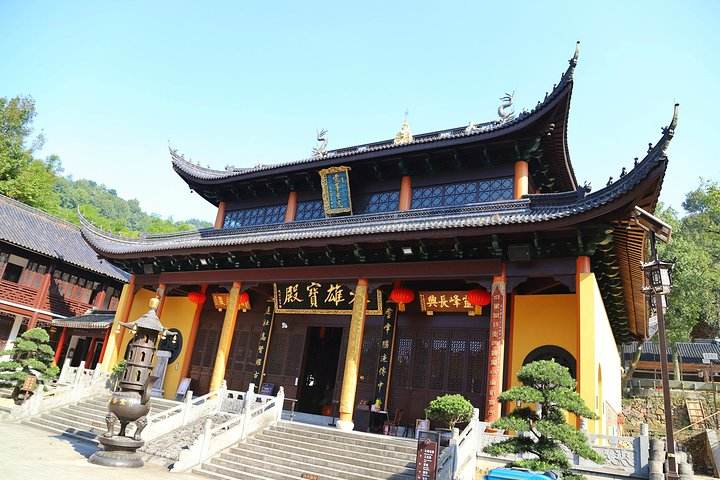
Evening Bell Ringing at Nanping Hill
At first sight,this spot might not seem to have any particular importance,but just close your eyes and listen.Around 4pm every day,the evening bell inside Jingci Temple on the northern slope of Nanping Hill resonates against the limestone hills;the sound travels across the lake and echoes when it meets the igneous stone of Geling Hill.The sound was of course more resonant in the bell’s younger days without the noise of the modern city,but this is still one of the oldest attractions on West Lake.Inside the maroon and butter-yellow Jingci Temple,pilgrims often line up and nurse home-brewed tea while monks ignite their incense sticks and pay homage.It’s also customary for local people in Hangzhou to visit Jingci Temple on Chinese New Year’s Eve to strike the bell in a spirit of respect and reflection.
Leifeng Pagoda in Evening Glow
The “glowing”reputation of this pagoda can be seen in the evening, when the hues of regal Buddhist red shine with the sunset. But, if you mention this site to anyone in China, the first thing to come to mind is the myth of the White Snake, who, legend has it, is still trapped beneath this towering monolith.
Solace in the Xixi Wetlands
When one thinks of wetlands what typically comes to mind are tracts of forest and marshes untouched by humans reaching out to the horizon.That’s not what you’ll find at the Xixi National Wetland Park.First of all,these are wetlands that have been painstakingly protected to reflect history-a fitting tribute to Hangzhou’s“man and nature”dance that has been going on for millennia.Second,the Xixi wetlands are just a short cab ride from downtown,so any alligators you were hoping to find have long since gotten jobs in the city.But,all this ignores the purpose of the wetlands:to preserve,protect,and guide the ancient natural beauty of Hangzhou.Today,just five kilometers from the bustling West Lake,nature lovers can traipse over 11 square kilometers of wetlands that have been cultivated by time and manicured by civilization.
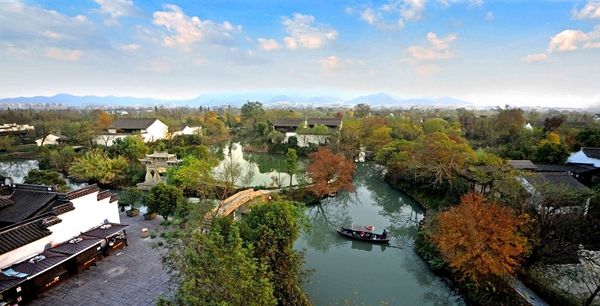
History of Xixi
It might seem somewhat strange to consider the history of a natural wetland,but so deep is the history of this area that you cannot talk about it without talking about the ancient,primitive people that shaped the area.Four to five thousand years ago,the Liangzhu people navigated what was then just a large lake in the spring and summer,enjoying the bounty that floated in from the rivers of Tianmu Mountain.When the waters retreated,they were left with the wetlands.
The history of the wetlands truly began with the construction of the Nanhu Lake forflood storage around 1,800 years ago,but it wasn’t until 988 that the Song began to develop Xixi Town-home to fishermen and silkworm farmers alike.Viewed as a utopia,Xixi almost became the location for the Southern Song’s royal palace.Fleeing from the failing Northern Song capital,Emperor Gaozong settled in the peaceful haven of Hangzhou and was eager to have his war-torn spirits recuperated.The tranquil waters and serene greenery of Xixi appealed to the emperor.But Phoenix Hill provided a more favorable strategic location and was eventually chosen.The emperor then told his officials:which loosely means“Save Xixi.”So Xixi was left in peace,and the quote today defines the conservation efforts of the wetlands.
Boating is a popular activity at the Xixi National Wetland Park For the true Xixi wetlands experience,there is no better way than booking the Fisherman Experience Tour.Interested visitors are encouraged to book online to experience the wetlands with a seasoned fisherman who,armed with nets and generations of knowledge,will hit the still waters to show you how to fish Xixi-style.For those interested in the fishing culture,head to the Misty Water Fishing Village where ramshackle fishing huts stand in the green waters.Inside are exhibitions of their simple,intriguing lives.
Fishermen’s Songs over the River
By Shi Dashan
Among the fishermen,never a greeting is extended;
Songs over the river are all they need.
In the melodies,time passes as the caltrop leaves turn green and reed catkins grow thick.
Over the creeks I angled,my heart for the worldly matters grew cold.
The wind on a small boat I would rather ride,into misty waves to a place no one can find.
The Literati of the lakes
It’s difficult to talk about anywhere in Hangzhou without talking about poetry,and in the Xixi wetlands the poets and scholars of antiquity lived in peaceful coexistence with nature,choosing it as a bedrock of inspiration.
Foremost among the attractions of the poetry of the Xixi wetlands is perhaps the Xixi Waterside Villas,considered even today as a site for great literary minds to meet.Nowadays,the site is mainly used as a sort of library of great works,divided into the Blue Stream Book House and the Yongshu Book Tower,where tourists can walk in the footsteps of the literary greats of years gone by.The reason for its stellar reputation(and,for that matter,its collections)is because it was agreed among many throughout Xixi’s long history that this was where inspiration was born.
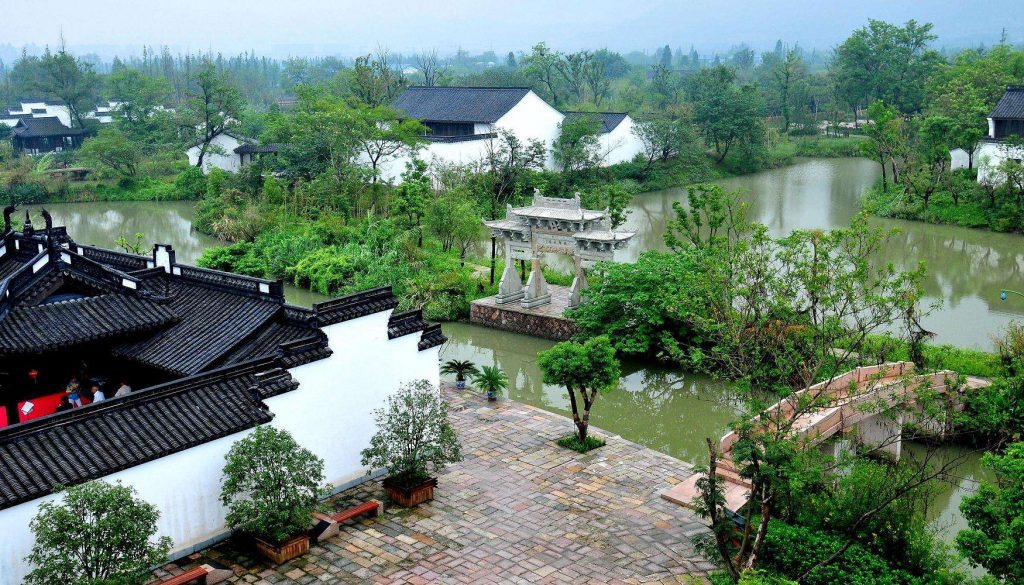
More specifically,one might want to visit the Plum and Bamboo Villa,built in the 18th century by literary man Zhang Cibai,where,you probably guessed,the highlight is the plum blossoms and thin,wispy strands of bamboo.Traveling southeast from there,literature lovers will find the famous Xixi Thatched House,formerly home to Ming Dynasty scholar and poet Feng Mengzhen.
For the most famous spot for literary inspiration in the wetlands,you’re going to need to take a boat.So secluded is the Autumn Snow Temple that it is only accessible by water on a solitary islet in the center of the wetlands surrounded by thick reeds.First built in the Song Dynasty,the temple took its name from the autumn scenery of flying reed catkins.A must-visit spot and inspiration for literati over centuries,the temple houses both Buddhist culture and memorial halls of poets from Zhejiang Province.
Thick reeds surround
Autumn Shew Temple
Birds and Natural Beauty
The natural beauty that inspired all those poets and scholars can still be found today,manicured,one might say,almost to a fault.The first thing that comes to mind when discussing the nature of the Xixi wetlands is that of the birds.While modernity may havechased out a number of predators that used to inhabit much of the area,the waterfowl and egrets of the area are simply stunning against a backdrop of idyllic scenery and Qing-era architecture.
The Xixi wetlands boast 180 different species of birds and are an ideal spot for catching delightful glimpses of egrets,kestrels,and kingfishers.Birds making their tireless journey from Siberia to Australia and back find solace in the calm waters,much to the en joyment of birdwatchers all over the world who come to hunt for rare species in this heavenly setting.
And,while birds may be what the park is most famous for(along with a few reptiles),its biodiversity is most visible at the Underwater Ecological Observation Corridor where curious passersby can observe some of the underwater creatures found in the wetlands.The water,you might expect,is a bit murky,but the fish,snails,and eels are surprisingly friendly-no doubt encouraged by unofficial feeding.And,if you’re really interested and entering from the southeastern gate,check out the National Wetland Museum of China.Here you’11 find dioramas of different wetlands throughout China,but you’ll also find an area on the top floor dedicated to the Xixi wetlands and their flora and fauna.
Getting Around Paradise
With 11.5 square kilometers of wetlands under conservation,even the most avid hiker will need to admit that doing the whole of the Xixi wetlands on foot is a fool’s errand.That said,there are a number of areas best seen walking at a slow pace,chief among these are the Green Causeway and the Blessed Causeway.The Green Causeway will take you by the Underwater Ecological Observation Corridor,but,more importantly,it takes you through the Hangzhou Wetland Botanical Garden,where fans of manicured topiary and flowers are in for a treat.To hike the Green Causeway,enter via the east gate or Wensan West Road access point and follow the signs.
Going west,the Green Causeway meets the Blessed Causeway,and here you’re going to need to make a choice.Head north to perhaps a more peaceful area,which includes the Jiang Village Leisure Life Block,to grab a bite to eat;or go straight ahead through Hezhu Street packed with shops and diners.South,however,is probably the best option;turn east at the end of causeway after a peaceful walk through the greenery,and you will find Gao Villa,former home to Emperor Kangxi’s favored official Gao Shiqi,a delicate garden complex once graced by the emperor himself.Then,head to the Lotus Shoal Bird Observation Area to catch a glimpse of the famous Flying Egrets at Lotus Shoal.
Reflection of Red Persimmon in Water is an iconic
site at the Xixi National Wetland Park
While a walk is certainly a welcome way to see the Xixi wetlands,you’re going to want a boat for the whole experience.Once you are on Hezhu Street,the closest dock is Shentankou;here’s where the wetlands journey really begins.Until now,while certainly marshy and with landscapes to amaze,your journey will have been relatively landlocked.Board one of the electric boats for a leisurely guided cruise on a circuit around some of the most amazing sites in the wetlands,including the thick reeds covering Autumn Snow Temple(the islet is accessible by sculling boat),Reflection of Red Persimmon in Water,and Plum and Bamboo Villa(best visited in September)where,incidentally,there is a harbor where one might hop on a sculling boat for a more intimate(though pricier)tour of the northern charms of the wetlands.Should you choose to stay on the electric boat,there’s another highlight ahead:Misty Water Fishing Village,an assembly of architecture and culture that brings the past to life.From here,you can give your rested feet a test and head back to the Blessed Causeway.
There is no right way to see the Xixi wetlands.It is an area of unmatched peace and quiet just a few kilometers from the city-teeming with history and hemmed by natural beauty.The only true thing that can be said of the Xixi wetlands is that if you haven’t seen them,you haven’t really seen Hangzhou.
The Bamboo-lined Path at Yunqi
While you’re enjoying the famous tea gardens of Hangzhou,you might find yourself in the relative peace of the Bamboo-lined Path at Yunqi.And,while the bamboo is certainly beautiful,there is more nature to the area than you might first imagine.
The start of the path does what it says on the tin:bamboo.For some,bamboo is regarded as a model for a proper gentleman in traditional Chinese culture,representinguprightness,elegance,and simplicity.As you ascend,you might also notice the sound of a creek running nearby.The bamboo lining slowly gives way to tightly packed trees and greenery that give the area the feel of a crowded canopy forest.
For diversity,you will want to hit up the Hangzhou Botanical Garden,but for a true look at the long stretch of Hangzhou’s proud forests,there is nowhere better than the bamboo-lined path.One often gets the impression in Chinese parks and sites that everything has been manicured almost beyond interest,but the bamboo-lined path has been spared.This is where you can see some of the most beautiful trees in East China.
Take,for instance,the 330-year-old Cinnamomum camphor tree about halfway up the path.The camphor is the official tree of Hangzhou,and the bulbous knots of its trunk and ovoid crown make it seem almost otherworldly.The rest of the path provides excellent information on trees that are even older-some more than 1,000 years old.
The main path is paved with cobblestones with a line running down the middle.It is said that,in Qing Dynasty,the middle section was reserved for emperors Kangxi and Qianlong during their visits here,and anyone who stepped on it would be arrested,or even executed.
Under the shade of historic trees and walking the path of the emperors,visitors reach the top of the path(where the bamboo is a faint memory)for what many consider to be the most beautiful view in all of Hangzhou.While all seasons offer great scenery atop thismile-long hike,”yunqi”means lingering clouds,so the best time to see it might be when fog is rushing over the tea fields to fill this ancient forest with an ethereal dignity.
Qiantang River Tidal Bore

Qiantang River is a capricious mother to the people that reside by her side.She is gentle and nurturing most of the time,but her dark mood swings have caused serious destruction.
Located on the lower reaches of the largest river in Zhejiang Province,Qiantang River runs through the central districts of Hangzhou from the southwest to the northeast.On itsnorth is the city’s cultural and historical center spreading to the east side of the West Lake,the land that once held the capitals of the ancient Wuyue Kingdom and the glorious Southern Song Dynasty.The southern bank holds the city’s urban future-prospected by both the city government and private developers.
If you trace the river upstream to the west,you will encounter its middle and upper
sections,Fuchun River and Xin’an River.This road that trips through the Hangzhou-Qiandao Express Highway offers a refreshing experience that will immerse you in the beauty of the green mountains and gentle rivers along the way,eventually leading to the lake resort paradise,Qiandao Lake,or“Thousand-Isle Lake”Downstream,the Qiantang River runs into the East China Sea at Hangzhou Bay-a bellshaped bay that opens up dramatically from a few kilometers to 100 kilometers.The unique shape of the river’s mouth,combined with tidal forces,created the world’s largest river tidal bore,where the difference between high and low tides can be as much as ten meters.It’s often described as roaring like thunder and resembling 10,000 horses galloping forward from the horizon.Though it appears every month,the best time to view the biggest tidal bore is around August 18 on the Chinese traditional calendar,which is around mid-September.As a popular tourism activity since as early as the seventh century,the event attracts tourists from all over the country.
The best location to view the tidal bore is in Yanguan Town,roughly 50 kilometers on the northeast of Hangzhou.But closer to home in Xiaoshan District,you can also find a tidal bore viewing area at Qiantang River Tidal Bore Watching Resort.
Though it is a special example of nature’s power,the tidal bore also poses a threat to the people along the river.Once flooded,it not only takes lives and destroys property,but the salty sea water can also ruin farmland for years.
Ancient people even created a legend to explain this natural phenomenon.It is said that a loyal minister named Wu Zixu in the Spring and Autumn Period was wrongfully forced to commit suicide by the king.In revenge,he pledged to turn into a spirit of the Qiantang River to haunt the city.It was the common belief that his spirit brought disaster,so the locals made sacrifices and held rituals to make peace with him.
It was King Qian Liu of the Wuyue Kingdom who finally had enough.Rebellious as he was,he led 500 soldiers to the bank and when the tide hit,he and his army shot 3,000 arrows into the tide to fight off the river spirit.Though it had about the same effect as the sacrifices,his act of defiance became a legend that served as testament to the determination of the local people to take fate into their own hands.Perhaps inspired by his spirit,the legend did have a happy ending that the wounded river god didn’t dare to haunt the city while it was under the protection of King Qian ever again.Today,you will find King Qian’s statue standing tall near King Qian’s Temple by the eastern bank of the West Lake,holding a bow and arrow,ready to fight for the city at any moment.
Countless years were spent building river dams here throughout history.In the Qing Dynasty,Emperor Qianlong visited Hangzhou six times.Though these royal visits wouldinspire endless bad TV dramas,he was just there to inspect the Qiantang River dams,which were of national importance.
Today’s modern architecture helps to keep the tidal bore at bay,but in recent years,there’s still occasional news of a tourist’s safety being compromised.So while appreciating the view,be sure to remember nature’s ruthless side and stay safe.
Liuhe Pagoda

The Liuhe Pagoda,or“The Pagoda of Six Harmonies”,is a giant,wooden,seven-storey pagoda that you can actually climb.Spacious corridors on each level and big windows open to all directions make this a great spot to view the natural scenery,most impressively the Qiantang River.First built in the tenth century with the belief that it could tame the tidal bore,it was also a beacon for boats cruising the Qiantang River at night.A decent spot to view the tidal bore,the pagoda has stood in relative peace,spared the brutalities of the recent and ancient past.


